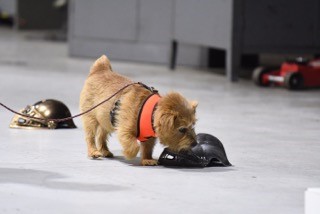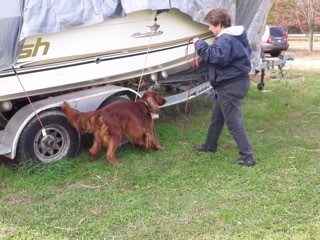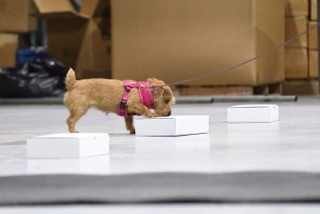Main Content
Scent work: What is it? And who can participate?

Answer: Anyone can participate with their dog! The American Kennel Club introduced this new canine sport in 2017 based on the job working detection dogs do to locate and communicate the location of the ‘hide’ back to their handler without disturbing the environment. This is a game dogs love to play as they are born with a powerful sense of smell. So it is only natural that any dog, regardless of breed, size, or shape, can be successful in this sport. We, as the handler, just have to learn how to read the dog’s body language. What fun that can be!
Detection work can be done in many different environments because odor is everywhere, on everything, and always changing. In hot weather the odor rises and in cold weather it collects on the ground passing through materials like dirt and water. Handlers must teach a dog to separate out the target odor (what we want) from all the other smells available.
Once the source of the target odor has been located, the dog must communicate their find to the handler. Each dog will develop their own way of sharing this information. Some may paw at the source, bark, point with their nose or body, sit, or lie down. There are many different ways a dog can communicate what they’ve discovered. It’s up to the handler to know the meaning of the dog’s behavior. The role of the handler is mostly passive, meaning that the dog is in control of where to go next. Handlers guide the dog only when necessary and tell the judge when the dog has located the odor.

AKC Scent Work is broken into two divisions which are Odor Search Division and Handler Discrimination Division. The difference between these divisions is whether the dog is searching for a specific odor or the scent of their handler. Searches are completed in four different environments known as “elements”. These include:
- Container: The target odor is concealed within a container (such as a cardboard box or briefcase), and the dog most indicate which container.
- Interior: The target odor is concealed on/in an object within an indoor search area.
- Exterior: The target odor is concealed on/in an object within an outdoor search area. This requires the dog to locate the scent despite changing airflow patterns, weather conditions, and natural distractions.
- Buried: The target odor is concealed within a small container and buried underneath the ground.
Each element has four difficulty levels which are Novice, Advanced, Excellent, and Master. The increasing difficulty requires dogs find the target odor within larger search areas and more hiding places. The highest level of competition is the Detective Class which mimics the true work of a detection dog. This level has an unknown number of hides in a variety of elements. Like most other AKC activities, the dog must qualify three times at each difficulty level before advancing to the next.
So how does someone and their dog get started in Scent Work? Members of the Winning Waggers 4-H Club started with basic obedience exercises so the dogs were comfortable in social environments. Then, handlers gave their dogs permission to sniff out cookies/treats hidden inside boxes. Over time, handlers increased the search area between boxes across the room. Next, they paired the odor of the treats with the odor used in Scent Work. These scents are birch, clove, anise, and cypress. Each step takes time so it is important to be patient and keep the training positive for both you and the dog.

Another strategy to teach scent work is the shell game or hide and seek. For these games, place high value and smelly treats (like hot dogs) inside a container. Then, hide it among similar containers so it’s unclear which one holds the treat. This is an easy game to play anywhere including your living room during bad weather. Use your imagination to come up with new ways to test your dog’s ability to locate the hidden treats.
To learn more about Scent Work, how to get started, and local events, visit the AKC Scent Work website. Be sure to check out this video which demonstrates Scent Work dogs in action.
By Lynne Godshall, 4-H Volunteer and President of Burlington County Kennel Club & Kelly Dziak, 4-H Program Associate, Rutgers Cooperative Extension